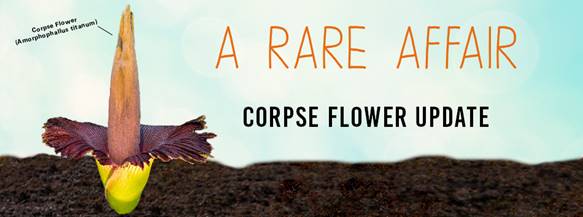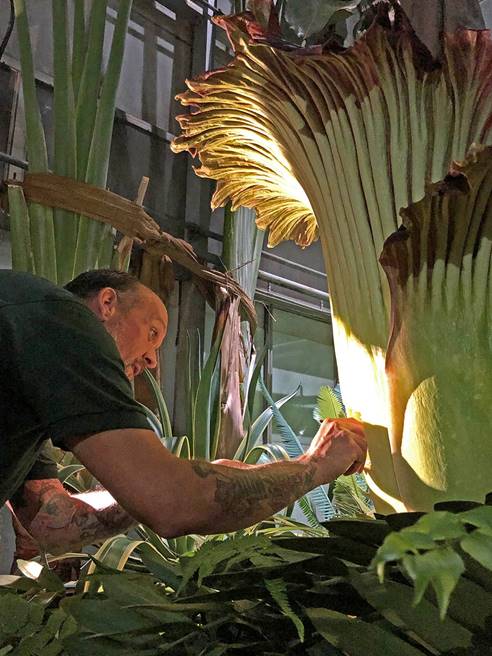
TORONTO ZOO & MCMASTER UNIVERSITY COLLABORATE ON FIRST-EVER PRESERVATION PROTOCOL FOR AMORPHOPHALLUS TITANUM POLLINATION

Paul Gellatly, Curatorial Gardner, Toronto Zoo with ‘Arthur’. Photo Credit: Jackie Patrick, McMaster University
TORONTO, ON, Wednesday, July 17, 2019: On Thursday, July 4, 2019, the Toronto Zoo and McMaster University collaborated on the first-ever preservation protocol for Amorphophallus titanum, also known as the corpse flower, pollination. Earlier in the week Toronto Zoo’s Curatorial Gardener, Paul Gellatly, contacted Dr. Susan A. Dudley, Professor, Department of Biology, McMaster University after hearing of both the impending and exciting news their corpse flower ‘Arthur’ would be blooming sometime within the next 24 to 48 hours. How does the Toronto Zoo fit into McMaster University’s momentous occasion? You might ask.
The Toronto Zoo, had it’s first-ever corpse flower, Pablo “Pe-ew” caso, bloom several years ahead of schedule in September 2018. Given the Zoo’s strong interest and focus on conservation; as well as having the facilities to properly store genetic material, the Zoo’s Reproductive Sciences team collected and froze pollen from ‘Pablo’. The pollen was stored in various ways to determine the best method for maintaining viability of the pollen following long term storage. One portion was frozen and stored at -80C, and another was cryogenically preserved in liquid nitrogen. This was done in the hopes of preserving genetics and pollinating future Amorphophallus titanum blooms in the collection.
The Toronto Zoo transported ‘Pablo’s’ frozen pollen to McMaster University on Thursday, July 4, 2019 and was invited to conduct viability testing on their blooming corpse flower ‘Arthur’. This was done to determine if cryogenics can provide a viable long term storage solution. Both McMaster University and the Toronto Zoo recognized the odds for cross-pollination were slim and that the window of opportunity was narrow, but they quickly worked together to navigate a time-sensitive situation. The perplexing science behind the corpse flower is the plant’s infrequent blooms. The odds that two plants in the same collection bloom simultaneously are quite low and therefore can’t be cross-pollinated. Furthermore, there is no recorded attempt of pollen preservation for this species, and so, a protocol does not exist. The Toronto Zoo’s Reproductive Sciences team developed a protocol from scratch using various plant science methods and examples, including orchids, to create a brand-new scientific protocol. McMaster University’s corpse flower ‘Arthur’s’ female inflorescence was divided into a grid and the Zoo was able to attempt cross-pollination with ‘Pablo’s’ pollen in four different treatment groups At this time it can be confirmed that ‘Arthur’ has accepted ‘Pablo’s’ pollen in all four different treatment groups, meaning the developed protocols provided some protection of the pollen during freezing. With that being said, more time is required to see if pollination has occurred, thereby confirming Pablo’s pollen was viable. It is presumed it will take another couple of weeks to determine the final outcome.
“This entire family of flowers has never been stored before, and therefore this particular cross-pollination has not been attempted,” says Dr. Gabriela Mastromonaco, Manager of Reproductive Sciences, Toronto Zoo. “This is the first step in developing a first-ever preservation protocol for the Amorphophallus titanum and we look forward to continuing to research the best options for long term storage of genetic plant material.”
“The sheer presence of these blooms is remarkable and something that continues to fascinate the wider public. This extreme form of plant reproduction is certainly a way of getting people engaged with the natural world and collaborations of this kind are important for conservation efforts,” says Susan Dudley, a professor of biology at McMaster University. “We are taking good care of Arthur and hoping for the best.”
Grown from seed, it can take six to ten years for a plant to produce its first flower, after which it can take several more years for it to bloom again. One of the reasons it takes so long between blooms is that the titan arum produces one of the largest flowering structures in the entire world. The pale central "tower" of the inflorescence, known botanically as a spadix, is typically two metres tall! This is wrapped in a single large spathe – a modified leaf that looks like a big bell – shaped petal. To match the corpse flower's aroma, this spathe has a dark red, ridged interior, which looks just like a piece of exposed flesh. Flies and beetles attracted by the odour crawl down the spathe to the base of the spadix, where the small flowers that produce pollen and seeds grow, enabling pollination. Since these pollinators tend to be nocturnal by nature, the blooms usually open in the late afternoon and then begin to wilt by the next morning. It's a lot of effort for a short window of opportunity.
This plant species is unique because of how infrequent it blooms, and because of how little time it has to be pollinated by only three species of beetle. Plants use all sorts of techniques to encourage animals to pollinate their flowers. Bright colours, perfumed fragrances, and sweet nectar encourage butterflies, bees, hummingbirds, sunbirds, and even bats to visit flowers, inadvertently carrying pollen and fertilizing seeds along the way. But while sweet-smelling, colourful flowers have been cultivated extensively by humans, this is not the only strategy that plants use for pollination. Native to the Indonesian island of Sumatra, the titan arum is related to peace and calla lilies. But, as you might guess from its name, the corpse flower's blossoms don't exactly smell like roses. Instead, this species relies on carrion beetles and flies for pollination, which it attracts with an aroma that – yes – resembles rotting meat. It's been called the plant kingdom's worst odour.
Like much of Sumatra's wildlife, including Sumatran orangutans and Sumatran tigers, the titan arum is threatened by habitat loss. Not only is space an issue, but as forests decline, so do hornbills, which are the corpse plant’s primary seed distributor. Thankfully, through advances in horticultural techniques, the intricacies of breeding this unusual plant are slowly being uncovered, allowing us to maintain them in managed care as insurance against a crash in their wild population. The Toronto Zoo is home to over 10 Amorphophallus titanum, and 13 other Amorphophallus species. Visit the Zoo’s Greenhouse daily from 10:00 am to 4:00 pm!
- 30 -
Toronto Zoo Media Contacts:
Katie Gray, Manager of Strategic Communications
[email protected] or #416-392-5941
Amanda Chambers, Supervisor of Strategic Communications
[email protected] or #416-392-5974
McMaster University Media Contact:
Michelle Donovan, Manager, Media Relations
Communications & Public Affairs
McMaster University
905-525-9140, ext. 22869 (w)
905-512-8548 (c)
[email protected]
About The Toronto Zoo
The Toronto Zoo is Canada’s premier zoo and a national leader in saving wildlife to ensure the rich diversity of nature for future generations. More than a tourist attraction, the Toronto Zoo boasts a number of leading programs for helping wildlife and their natural habitats – from species reintroduction to reproductive research. A world-class educational centre for people of all ages, the Toronto Zoo is open every day except December 25 and attracts approximately 1.3 million visitors each year.
About McMaster University
McMaster University is Canada’s most research-intensive university and is consistently ranked as one of the world’s Top 100 universities. Together, our researchers, students and staff advance human and societal health and well-being, creating a Brighter World.



